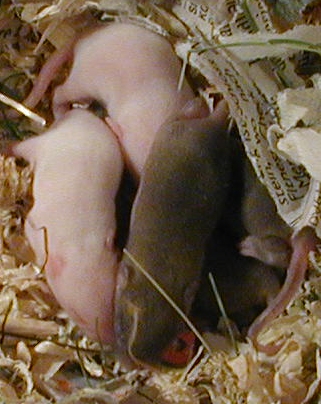
While there have been a lot of studies trying to figure out if traits really can be inherited through epigenetics, many of them have been inconclusive or suffer from experimental design flaws. However, I recently ran across a study that I think produces the most convincing argument yet that at least some new traits can be passed from parents to offspring (and beyond) without any change in the genes themselves.
In the experiment, the authors started by exposing male mice to acetophenone, a chemical that has a fruity smell. When the mice were exposed to the chemical, they were also given a mild electrical shock. As a result, the mice began to associate the shock with the smell. After a while, the mice would shudder when they smelled acetophenone, even if they weren’t given a shock. The authors then bred those males with females who had never been exposed to acetophenone. During the entire time the offspring from this mating were raised, neither the offspring nor the parents were exposed to acetophenone. Once the offspring matured, they were then exposed to acetophenone, and they shuddered, even though no shock was given to them. When those offspring were bred, their offspring also exhibited the same behavior. Offspring bred from males who had not been conditioned with acetophenone and shock did not shudder when exposed to the chemical.1
Now, of course, there are several possible explanations for these results, and had the authors stopped there, the paper would not be nearly as convincing as it is. However, the authors did several follow-up experiments that seemed to rule out any explanation other than inheritance.
The most obvious explanation for the results is that the males trained their offspring in some way, even though the offspring were never actually exposed to the smell in the presence of their parents. However, that was ruled out when the authors used in vitro fertilization to produce the offspring. Remember, the females were not conditioned – only the males were. By doing in vitro fertilization, then, the authors got rid of any exposure the offspring had to the only adult that had been conditioned. Nevertheless, they still had a shudder reaction to the smell of acetophenone.
The authors then conditioned females to associate the smell of acetophenone with a shock and bred them with males who had never been conditioned. When the offspring were born, they then transferred them to mothers who had never been conditioned. In addition, the conditioned mothers were given pups from parents that had never been conditioned. When all these offspring matured, the ones that came from the conditioned females had a shudder reaction to smell of acetophenone, despite the fact that they were raised by an unconditioned mother. The offspring that came from the unconditioned parents did not have a shudder reaction to acetophenone, despite the fact that they were raised by a conditioned mother. It seems clear, then, that the shudder response was not learned. It was inherited.
When the authors examined the gene involved in smelling acetophenone, they found that the gene itself was the same in offspring and parent. However, it had fewer methylation marks in the parents that had been conditioned, as well as their offspring. What are methylation marks? An organism can change how its genes are expressed by adding small chemical groups (called methyl groups) to the genes. This doesn’t affect the genes themselves; it only affects how often the genes are used by the organism. Fewer methylation marks usually means a gene is used more frequently.
In the end, then, the authors think that the conditioned parents altered the methylation of the gene that is used to smell acetophenone so that it would be used more often. The parents then passed that methylation pattern to the offspring, along with the gene itself. Even though the gene was unchanged, the fact that there were fewer methylation marks meant that the offspring used the gene more, which made them more sensitive to acetophenone and somehow also transferred the association of the smell with pain. This conclusion is supported by the fact that the offspring of a conditioned parent had more neurons associated with the detection of acetophenone in their brains as compared to the offspring of unconditioned parents. As the authors state:
To conclude, we interpret these results as highlighting how generations can inherit information about the salience of specific stimuli in ancestral environments so that their behavior and neuroanatomy are altered to allow for appropriate stimulus-specific responses.
In other words, not only are physical characteristics inheritable, but so are certain responses to stimuli. In some cases, this inheritance can produce new responses without altering the genes in any way. This allows for the environment to shape inheritance, at least to some extent. If this study’s results are confirmed by other studies (and I think they will be), the process of inheritance is a lot more complicated than anyone thought a decade ago!
REFERENCE
1. Brian G Dias and Kerry J Ressler, “Parental olfactory experience influences behavior and neural structure in subsequent generations,” Nature Neroscience 17:89–96, 2014
Return to Text
